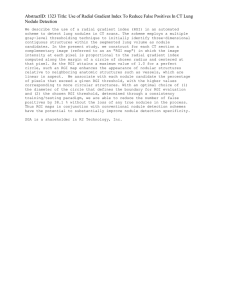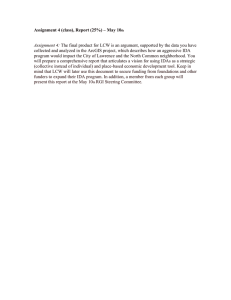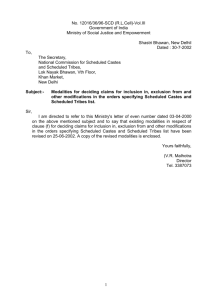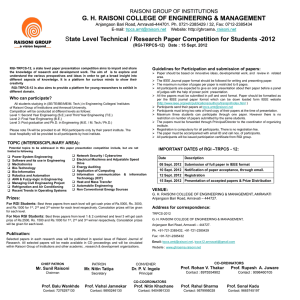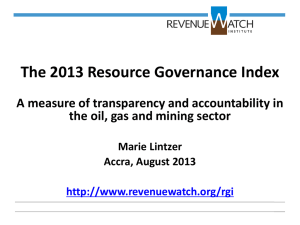Pressure Difference Across the Free Surface of a Stable
advertisement
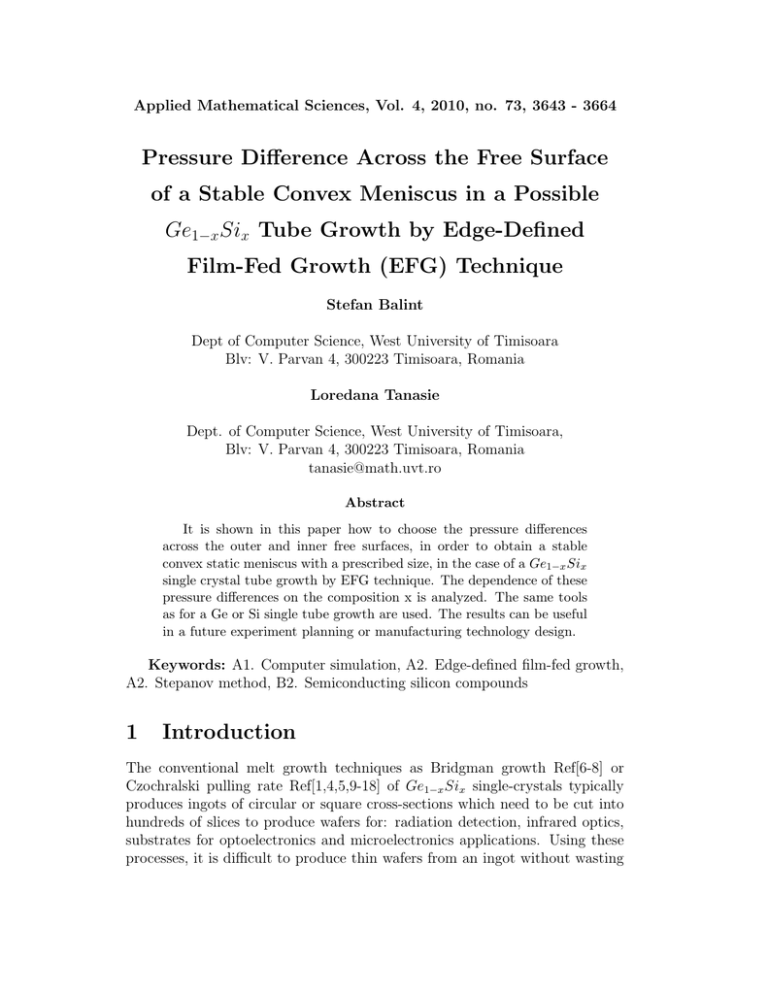
Applied Mathematical Sciences, Vol. 4, 2010, no. 73, 3643 - 3664 Pressure Difference Across the Free Surface of a Stable Convex Meniscus in a Possible Ge1−x Six Tube Growth by Edge-Defined Film-Fed Growth (EFG) Technique Stefan Balint Dept of Computer Science, West University of Timisoara Blv: V. Parvan 4, 300223 Timisoara, Romania Loredana Tanasie Dept. of Computer Science, West University of Timisoara, Blv: V. Parvan 4, 300223 Timisoara, Romania tanasie@math.uvt.ro Abstract It is shown in this paper how to choose the pressure differences across the outer and inner free surfaces, in order to obtain a stable convex static meniscus with a prescribed size, in the case of a Ge1−x Six single crystal tube growth by EFG technique. The dependence of these pressure differences on the composition x is analyzed. The same tools as for a Ge or Si single tube growth are used. The results can be useful in a future experiment planning or manufacturing technology design. Keywords: A1. Computer simulation, A2. Edge-defined film-fed growth, A2. Stepanov method, B2. Semiconducting silicon compounds 1 Introduction The conventional melt growth techniques as Bridgman growth Ref[6-8] or Czochralski pulling rate Ref[1,4,5,9-18] of Ge1−x Six single-crystals typically produces ingots of circular or square cross-sections which need to be cut into hundreds of slices to produce wafers for: radiation detection, infrared optics, substrates for optoelectronics and microelectronics applications. Using these processes, it is difficult to produce thin wafers from an ingot without wasting 3644 S. Balint and L. Tanasie 40-50% of material as kerf, during the cutting process. In addition, a subsequence of wafering is the surface damage, which needs to be removed by etching and polishing. The saving process followed by polishing increases the costs of the wafer production. The high costs of Ge1−x Six wafer affect their widespread use. For this reason the EFG technology can be more appropriate to produce Ge1−x Six single crystals with prescribed shapes and sizes, without any additional machining. For references concerning successful Si tube growth see Ref[3]. We have not found, in the literature, papers concerning Ge1−x Six tube growth by EFG technique, for x = 0 and x = 1. The fact that Ge1−x Six single crystal growth is possible by Czochralski technique for x = 0 and x = 1, suggests that the growth has to be possible also by EFG technique. It is shown in this paper how the pressure difference across the outer and inner free surfaces has to be chosen, in order to obtain a stable convex static meniscus with prescribed size and shape. 2 The free surfaces equations In hydrostatic approximation, the equations of outer and inner free surface of the static meniscus for the growth of a single crystal tube by EFG technique are: ze ρ · g · ze − pe 1 Rge + Rgi 2 3/2 2 1 + (ze ) = − · 1 + (ze ) · ze , r ∈ , Rge , γ r 2 (1) and: zi ρ · g · zi − pi 1 Rge + Rgi 2 3/2 2 1 + (zi ) = − · 1 + (zi ) · zi , r ∈ Rgi , , γ r 2 (2) respectively. Here: γ is the surface tension, ρ is the melt density, g is the gravitational acceleration; ze and zi are the vertically upwards oriented coordinates with respect to the Oz axis, r is the radial coordinate with respect to Or axis, Rge and Rgi are the outer and inner radii of the shaper, pe and pi are the pressure differences across the outer and inner free surface, respectively: pe = pm − peg − ρ · g · H pi = pm − pig − ρ · g · H (3) Pressure difference across the free surface 3645 where: pm denotes the hydrodynamic pressure in the meniscus melt; peg and pig are the gas pressures in the exterior and interior of the tube, respectively; H denotes the melt column height between the horizontal crucible melt level and the shaper top level (Fig 1.). Figure 1: Prototype tubular crystal growth by EFG technique The solution ze = ze (r) of the equation (1) has to satisfy the following conditions: ⎧ π ⎪ ze (re ) = − tan − αg ⎪ ⎪ ⎪ 2 ⎪ ⎨ ze (Rge ) = − tan αc ⎪ ⎪ ⎪ ⎪ ⎪ ⎩ ze (Rge ) = 0 and ze (r) is strictly decreasing on [re , Rge ] (4) Rgi + Rge , Rge is the tube outer radius; αg is the growth angle; where: re ∈ 2 αc is the contact angle the outer free surface and the outer edge of between π the shaper top, αc ∈ 0, − αg (Fig 1.). 2 The solution zi = zi (r) of the equation (2) has to satisfy the following conditions: 3646 S. Balint and L. Tanasie ⎧ π ⎪ z − α (r ) = tan ⎪ i g i ⎪ ⎪ 2 ⎪ ⎨ (5) zi (Rgi ) = tan αc ⎪ ⎪ ⎪ ⎪ ⎪ ⎩ zi (Rgi ) = 0 and zi (r) is strictly increasing on [Rgi , ri ] Rgi + Rge where: ri ∈ Rgi , is the tube inner radius; αg is the growth angle; 2 αc is the contact angle between the inner free surface and the inner edge of π the shaper top, αc ∈ 0, − αg (Fig 1.). 2 In Ref [2] the following statements were shown: Statement 2.1 If there exists a solution ze (r)of the equation (1) which Rge 2Rge ∈ 1, and pe , the satisfies (4) and ze (r) > 0 then, for n = re Rgi + Rge following inequalities hold: π − (αc + αg ) n γ n − ·γ· 2 · γ· · cos αc + · sin αc ≤ pe ≤ − n−1 Rge Rge n−1 π π − (αc + αg ) γ n−1 · ρ · g · Rge · tan − αg + n · · sin αg + · cos αg ·2 Rge n 2 Rge (6) Rgi + Rge , eq (1) has a solution ze (r) which 2 satisfies (4) and ze (r) > 0, then the following inequalities hold: π − (αc + αg ) γ · cos αc + · sin αc ≤ pe ≤ −2 · γ· −2 · γ · 2 Rge − Rgi Rge Consequence. If for re = π π − (αc + αg ) Rge − Rgi 2·γ · tan − αg + · sin αg + ρ · g · · cos αg ·2 Rge − Rgi 2 2 Rgi + Rge (7) 2 · Rge the Statement 2.2 If for pe (defined by (3)) and n ∈ 1, Rgi + Rge following inequality holds: π − (αc + αg ) n γ 2 · pe < −γ · · cos αc + · sin αc , (8) n−1 Rge Rge 3647 Pressure difference across the free surface Rge , Rge and a solution ze (r) of then there exists re in the closed interval n the equation (1) which satisfies (4) and ze (r) > 0. 2 · Rge and the outer pressure Statement 2.3 If for 1 < n < n < Rgi + Rge difference pe the following inequalities hold: π π − (αc + αg ) n n − 1 + · sin αg + ρ · g · Rge · − α · · tan −γ · 2 g Rge n −1 n 2 π − (αc + αg ) γ n γ + · n · cos αg < pe < −γ · 2 · · n · sin αc , + Rge Rge n − 1 Rge (9) Rge Rge and a solution ze = ze (r) of the equation (1) , then there exists re ∈ n n which satisfies (4) on [re , Rge ] and ze (r) > 0. 2 · Rge Statement 2.4 If for n ∈ 1, and pe the following inequality Rgi + Rge holds: n−1 γ · ρ · g · Rge · tan αc + n · , (10) pe > n Rge Rge then there is no re ∈ , Rge such that the equation (1) has a solution n which satisfies (4). Comments. 1) The value of pe = pm − peg − ρ · g · H can be controlled by the values peg and H. It is commonly accepted that pm = 0. 2) The above statements offer the possibility to control the shape and the size of the outer free surface by the values of pe . In the next section, it will be shown how this can be done in the case of a Ge1−x Six meniscus. of the equation Statement 2.5 If there exists a solution zi (r) (2), which ri Rgi + Rge satisfies (5) and zi (r) > 0, then for m = ∈ 1, and pi the Rgi 2 · Rgi following inequalities hold: π − (αc + αg ) 1 γ 1 ·γ· 2 · − · cos αc − · cos αg ≤ pi ≤ −γ · m−1 Rgi Rgi m−1 π π 1 − (αc + αg ) γ 2 − αg + · · · sin αg + (m − 1) · ρ · g · Rgi · tan · sin αc . Rgi 2 m Rgi (11) 3648 S. Balint and L. Tanasie Rgi + Rge , eq (2) has a solution zi (r) which 2 satisfies (5) and zi (r) > 0, then the following inequalities hold: Consequence. If for ri = π π − (αc + αg ) − (αc + αg ) γ 2 2 −2 · γ · · cos αc − · cos αg ≤ pi ≤ −2 · γ · · Rge − Rgi Rgi Rge − Rgi · sin αg + ρ · g · π Rge − Rgi 2·γ · tan − αg − · sin αc 2 2 Rgi + Rge (12) Rgi + Rge and pi the following inequality Statement 2.6 If for m ∈ 1, 2 · Rgi holds: π − (αc + αg ) 1 γ · 2 · cos αc − · sin αg , (13) pi < −γ · m−1 Rgi Rgi then there exists ri in the closed interval [Rgi , m · Rgi ] and a solution zi (r) of the equation (2) which satisfies (5) and zi (r) > 0. Statement 2.7 If for 1 < m < m < Rgi + Rge and the inner pressure 2 · Rgi difference pi the following inequalities hold: π π − (αc + αg ) 1 2 ·γ· − αg − · sin αg + ρ · g · Rgi · (m − 1) · tan − m −1 Rgi 2 π − (αc + αg ) γ 1 γ 1 2 · · · sin α < p < −γ · · cos αc − · cos αg , g i m Rgi m−1 Rgi Rgi (14) then there exists re ∈ [m · Rgi , m · Rgi ] and a solution zi (r)of the equation (2) which satisfies (5) and zi (r) > 0. Rgi + Rge Statement 2.8 If for m ∈ 1, and pi the following inequality Rgi holds: γ pi > (m − 1) · ρ · g · Rgi · tan αc + , (15) Rgi then there is no ri ∈ [Rgi , m · Rgi ] such that the equation (2) has a solution which satisfies (5). Pressure difference across the free surface 3649 Comments: . 1) The value of pi = pm − pig − ρ · g · H can be controlled by the values pig and H. (It is commonly accepted that pm = 0.) 2) The above statements offer the possibility to control the shape and the size of the inner free surface by the values of pi . In the next section, it will be shown how to this can be done in the case of a Ge1−x Six meniscus. 3 The pressure differences for a stable convex static Ge1−xSix meniscus with a prescribed size It will be shown in this section how the explicit formulas established theoretically, can be used for the choice of pe and pi in order to obtain a stable convex static Ge1−x Six meniscus with a prescribed size. The computation for Ge 0.98 Si 0.02 tube when Rgi = 0.0042[m] and Rge = 0.0048[m] are performed in MathCAD v.13. The numerical values of ρ, g, γ, αc , αg for Ge and Si are given in Table 1: ρ γ αg αc g Table 1. Ge Si 5.6 × 103 [kg/m3] 2.5 × 103 [kg/m3] 6.2 × 10−1[N/m] 7.2 × 10−1 [N/m] 47o = 0.82 [rad] 30o = 0.523 [rad] o 12 = 0.209 [rad] 11o = 0.192 [rad] 9.81[m/s2] 9.81[m/s2] It is assumed that ρ, g, γ, αc , αg for Ge1−x Six are given by the formulas [4]: ρ(x) = 5.6 · 103 · (1 − x) + 2.5 · 103 · x [kg/m3 ] γ(x) = 6.2 · 10−1 · (1 − x) + 7.2 · 10−1 · x [N/m] αc (x) = 0.82 · (1 − x) + 0.523 · x [rad] αg (x) = 0.209 · (1 − x) + 0.192 · x [rad] (16) for 0 ≤ x ≤ 1. For the given numerical values (x=0.02), the pressure difference limits es- 3650 S. Balint and L. Tanasie tablished in Statement 1 and given by the inequality (6) are: π − (αc + αg ) n γ ·γ· 2 Le1 (n) = − · cos αc + · sin αc n−1 Rge Rge π π − (αc + αg ) n n−1 ·γ· 2 · ρ · g · Rge · tan − αg + Le2 (n) = − · sin αg + n−1 Rge n 2 +n · γ · cos αg . Rge (17) Rge ∈ For different values of n = re sented in Fig. 2: 1, 2Rge , these limits are repreRgi + Rge Pressure difference across the free surface 3651 Figure 2: The pressure limits Le1 and Le2 for different values of n 2 · Rge are: The values of Le1 (n), Le2 (n) for n = Rgi + Rge π − (αc + αg ) γ Le1 = −2 · γ · 2 · cos αc + · sin αc = −684.6 [Pa] Rge − Rgi Rge π π − (αc + αg ) Rge − Rgi · tan − αg + Le2 = −2 · γ · 2 · sin αg + ρ · g · Rge − Rgi 2 2 + 2·γ · cos αg = −23.531 [Pa]. Rgi + Rge For a value p0e of pe , which is less than Le1 = −684.6[Pa] (p0 < Le1 = −684.6[Pa]), there exists n0 and n0 such that p0e = Le1 (n0 ) = Le2 (n0 ) and 1 < n0 < n0 . The numbers n0 and n0 can be found solving the equations Le1 (n) = p0e and Le2 (n ) = p0e . For p0e , n0 , n0 the inequalities (9) hold. Hence, the growth angle is reached at a point re (p0e ) for every p0e < Le1 = −684.6[Pa] Rge Rge , . For instance, if p0e = 2Le1 = −1369.2[Pa] which is in the range n0 n0 then n0 = 1.034407, n0 = 1.009851 and the growth angle is reached at a point re (p0e ) in the range [0.00464, 0.004753][m]. 3652 S. Balint and L. Tanasie Comments: 1. When pe < Le1 = −684.6[Pa] decreases towards −∞, then n0 and n0 Rge Rge tend to 1, the range , becomes smaller and smaller thin and n0 n0 re (pe ) tends to Rge . Physically, this situation is not plausible because pe is bounded below. 2. Neglecting for example pm and peg in the formula pe = pm − peg − ρ · g · H, it is found that, for p0e = Le1 = −684.6[Pa], the level difference H has Le to be − 1 = 1.26 × 10−2 [m] and for p0e = 2 · Le1 = −1369.2[Pa], H ≈ ρ·g 2 · Le1 = 2.52 × 10−2 [m]. − ρ·g e 3. For a value p0e of pe which is larger than L2 = −23.531[Pa] there is no Rgi + Rge point re in the range , Rge at which the growth angle is 2 reached. This is a consequence of the Statement 2.1. 4. In fact, what happens when pe is larger than Le2 = −23.531 [Pa] is not physically interesting because the point re , where the growth angle is Rgi + Rge . eventually reached, is less than 2 5. What happens when pe is in the range [Le1 , Le2 ] = [−686.4, −23.531][Pa] does not result from the above considerations. This can be clarified numerically integrating the equations: ⎧ dze ⎪ ⎪ ⎪ ⎨ dr = − tan (αe ) (18) ⎪ ⎪ p 1 − ρ · g · z 1 dα e e e ⎪ ⎩ = · − · tan αe dr γ cos αe r for z(Rge ) = 0 and α(Rge ) = αc . 1. In order to illustrate the above facts (also for pe < Le1 ) we have solved (18) for pe ∈ [−4000, Le2 ][Pa]. The values of re (pe ), where the growth angle is reached and the corresponding meniscus height he (pe ) for pe ∈ [−4000, −1000][Pa], are represented in Fig. 3 and Fig 4. Pressure difference across the free surface 3653 Figure 3: The dependence of the outer radius on the outer pressure difference Figure 4: The dependence of the outer meniscus height on the outer pressure difference 3654 S. Balint and L. Tanasie Fig. 3 shows that, if pe increases, re (pe ) decreases and it will be physically interesting for pe < −300[Pa]. If pe is higher than −300[Pa], then re (pe ) is less Rgi + Rge . then 2 Moreover, it can be seen, for example, that tubes with the outer radius re in the range [4.51 × 10−3 , 4.52 × 10−3 ][m], can be obtained when pe is in the range [−432.52, −412.81][Pa] (Fig. 3). The above presented results concern the outer free surface of the meniscus. For the inner free surface we have to consider the pressure limits established in Statement 2.5 and given by the inequalities (11): π − (αc + αg ) 1 γ ·γ· 2 Li1 (m) = − · cos αc − · cos αg m−1 Rgi Rgi π π − (αc + αg ) 1 2 i ·γ · − αg + L2 (m) = − · sin αg + (m−1) · ρ· g · Rgi · tan m−1 Rgi 2 1 γ · · sin αc . m Rgi ri Rgi + Rge Fig. 5 shows these limits for different values of m = ∈ 1, : Rgi 2 · Rgi Figure 5: The pressure limits Li1 and Li2 for different values of m Rgi + Rge are: The values of Li1 (m), Li2 (m) for m = 2 · Rgi π − (αc + αg ) γ · cos αc − · cos αg = −809.58 [P a] Li1 = −2 · γ · 2 Rge − Rgi Rgi Pressure difference across the free surface 3655 π π − (αc + αg ) Rge − Rgi 2·γ i 2 L2 = −2·γ · ·sin αg +ρ·g · · ·tan − αg + Rge −Rgi 2 2 Rgi + Rge sin αc = −59.215[P a] For a value p0i of pi , which is less than Li1 = −809.58[Pa] (p0i < Li1 ), there exist m0 and m0 such that p0i = Li1 (m0 ) = Li2 (m0 ) and 1 < m0 < m0 . The numbers m0 and m0 can be found solving the equations Li1 (m) = p0i and Li2 (m ) = p0i . For p0i , m0 , m0 inequalities (14) hold. Hence, for every the growth angle is reached at a point ri (p0i ) which is p0i < Li1 = −809.58[Pa] in the range m0 · Rgi , m0 · Rgi . For instance, if p0i = 2 · Li1 = −1619.16[Pa] then m0 = 1.035023, m0 = 1.009769 and the growth angle is reached at a point ri (p0i ) in the range [0.004241, 0.004347][m]. Comments: 1. When pi < Li1 = −809.58[Pa] decreases towards −∞, then m0 and m0 tend to 1, the range [m0 · Rgi , m0 · Rgi ] becomes smaller and smaller and ri (pi ) tends to Rgi . Physically, this situation is not plausible because pi is bounded below. 2. Neglecting for example pm and pig in the formula of pi = pm −pig −ρ·g ·H, it is found that for p0i = Li1 = −809.58[Pa] the level difference H has to Li be H ≈ − 1 = 1.5 × 10−2 [m] and for p0i = 2 · Li1 = −1619.16[Pa], it ρ·g 2 · Li1 has to be H ≈ − = 3 × 10−2 [m]. ρ·g i 3. For a value p0i of pi which is greater than L2 = −59.215[Pa], there is Rgi + Rge no point ri in the range Rgi , at which the growth angle is 2 reached. This is a consequence of the Statement 5. 4. In fact, what happens when pi is larger than Li2 = −59.215 [Pa] is not so interesting from the physical point view because ri , for which the growth Rgi + Rge . angle eventually is reached, is larger than 2 5. What happens when pi is in the range [Li1 , Li2 ] = [−809.56, −59.215][Pa] does not result from the above considerations. This can be clarified 3656 S. Balint and L. Tanasie integrating numerically the equations: ⎧ dzi ⎪ ⎪ ⎪ ⎨ dr = tan αi ⎪ ⎪ ρ · g · zi − pi 1 dαi 1 ⎪ ⎩ = · − · tan αi dr γ cos αi r (19) for z(Rgi ) = 0 and α(Rgi ) = αc . In order to illustrate the above facts (also for pi < Li1 ) we have solved (19) for pi ∈ [−4000, Li2 ][Pa]. The values of ri (pi ), where the growth angle is reached, and the corresponding meniscus height hi (pi ), for pi ∈ [−4000, −100][Pa], are represented in Fig. 6 and Fig 7.: Figure 6: The dependence of the inner radius on the inner pressure difference Fig. 6 shows that if pi increases then ri (pi ) increases as well and it is physically interesting for pi < −600[Pa]. If pi is higher than −600[Pa], then Rgi + Rge . ri (pi ) is larger than 2 Moreover, it can be seen, for example, that tubes with inner radius ri in the range [4.48 × 10−3 , 4.49 × 10−3][m] can be obtained when pi is in the range [−668.21, −648.43][Pa] (Fig. 6). Pressure difference across the free surface 3657 Figure 7: The dependence of the inner meniscus height on the inner pressure difference Fig. 7 shows that if pi increases then hi (pi ) increases too. When pi is in the range [−668.21, −648.43] [Pa] then hi (pi ) is in the range [5.34 · 10−4 , 5.53 · 10−4 ][m]. All these results are dependent on x, which define the composition of the Ge1−x Six tube, and on the shaper radii Rgi , Rge . For instance, in Section 4 the dependence on the composition x is analyzed for the fixed shaper radii Rgi = 0.0042[m], Rge = 0.0048[m]. 4 The dependence of the pressure difference on the Ge1−x Six tube composition x The dependence of the limits: π − (αc + αg ) γ · cos αc + · sin αc Le1 (x) = −2 · γ · 2 Rge −Rgi Rge π π − (αc + αg ) Rge − Rgi · tan − αg + Le2 (x) = −2 · γ · 2 · sin αg + ρ · g · Rge − Rgi 2 2 2·γ · cos αg Rgi + Rge π − (αc + αg ) γ Li1 (x) = −2 · γ · 2 · cos αc − · cos αg Rge − Rgi Rgi 3658 S. Balint and L. Tanasie π π − (αc + αg ) Rge − Rgi · tan − αg − Le2 (x) = −2 · γ · 2 · sin αg + ρ · g · Rge − Rgi 2 2 2·γ · sin αc Rge + Rgi on the composition x were found using the formulas (15). These dependences are presented in Fig. 8. and Fig. 9: Figure 8: The dependence of the pressure limits Le1 and Le2 on the composition Figure 9: The dependence of the pressure limits Li1 and Li2 on the composition Figs. 8, 9 show that when x increases, Le1 (x), Le2 (x), Li1 (x),Li2 (x) decrease and the differences Le2 (x) − Le1 (x), Li2 (x) − Li1(x) increase. Rge Rge The dependence of the estimated ranges n , n , [m0 · Rgi , m0 · Rgi ] on 0 0 the composition x for p0e = 2 · Le1 and p0i = 2 · Li1 respectively are represented in Fig. 10 and Fig. 11. 3659 Pressure difference across the free surface Rge Rge Figure 10:The dependence of the estimated ranges n , n on the composition 0 0 Figure 11: The dependence of the estimated ranges [m0·Rgi , m0·Rgi ] on the composition Figs. 10, 11 show that the dependence of the estimated range of the outer and inner radius of the tube on the composition x is not significant. The dependence of pe on the composition x, used to obtain a Ge1−x Six tube of outer radius re = 0.00455[m], is represented in Fig. 12. 3660 S. Balint and L. Tanasie Figure 12: The dependence of the outer pressure pe on the composition x In Fig. 13. the corresponding meniscus heights are presented as function of the composition x. Figure 13: The dependence of the outer meniscus height he on the composition The dependence of pi on the composition x, used to obtain a Ge1−x Six tube of inner radius ri = 0.00445[m], is represented in Fig. 14. Pressure difference across the free surface 3661 Figure 14: The dependence of the inner pressure pi on the composition x In Fig. 14. the corresponding meniscus height is presented as a function of the composition x. Figure 15: The dependence of the inner meniscus height hi on the composition In Fig. 16. the corresponding H, the melt column height between the horizontal crucible melt level and the shaper top level (in the condition pm =peg ), is presented as a function of the composition x for the outer free surface. 3662 S. Balint and L. Tanasie Figure 16: The dependence of the melt column height between the horizontal crucible melt level and the shaper top level on the composition x for the outer free surface In Fig. 17. the corresponding H, the melt column height between the horizontal crucible melt level and the shaper top level (in the condition pm =pig ), is presented as a function of the composition x for the inner free surface. Figure 17: The dependence of the melt column height between the horizontal crucible melt level and the shaper top level on the composition x for the inner free surface Conclusions 1. The pressure differences pe , pi across the outer and inner free surfaces needed for obtain a Ge1−x Six tube of given outer and inner radii, decrease when x increases. 2. The melt column height between the horizontal crucible melt level and the shaper top level, needed to obtain a Ge1−x Six tube of given outer and inner radii, has to be increased when x increases. Pressure difference across the free surface 3663 Acknowledgment The authors thank to Romanian National Authority for Research for supporting this research under the grant no. 7/2007. References [1] N. V. Abrosimov, S. N. Rossolenko, W. Thieme, A. Gerhardt, W. Schroder, J. Crystal Growth, 174 (1997) 182. [2] St. Balint, A.M. Balint, Inequalities for single crystal tube growth by edge-defined film-fed (EFG) technique submitted in 2007 to Applied Mathematical Modelling. [3] St. Balint, A.M. Balint, L. Tanasie, J. Crystal Growth, 310 (2008) 382. [4] Jiahe Chen, Deren Yang, Hong Li, Xiangyang Ma, Dualin Que, J. Crystal Growth, 291 (2006) 66. [5] B. Depuyt, A. Theuwis, I. Romandic, Materials Science in Semiconductor Processing, 9 (2006) 437. [6] Kenji Kadokura, Yukio Takano, J. Crystal Growth, 171 (1997) 56. [7] T.A. Lograsso, D.L. Schlagel, A.O. Pecharsky, J. of Alloys and Compounds, 363 (2005) 141. [8] C. Marin, A. Ostrogorsky, J. Crystal Growth 211 (2000) 378. [9] Xianhuan Niu, Weilian Zhang, Guoqi Lu, Zhongwei Jiang, J. Crystal Growth, 267 (2004) 424. [10] Xianhuan Niu, Weilian Zhang, Enhuai Zhang, Jungsheng Sun, J. Crystal Growth, 263 (2004) 167. [11] O. V. Smirnova, V.V. Kalaev, Yu. N. Makarov, N.V. Abrosimov, H. Riemann, V.N. Kurlov, J. Crystal Growth 303 (2007) 141. [12] Toshinori Taishi, Xinming Huang, Ichiro Yonega, Keigo Hoshikawa, J. Crystal Growth, 258 (2003) 58. [13] Deren Yang, jiahe Chen, Hong Li, Xiangyang Ma, Daxi Tian, Liben Li, Dualin Que, J. Crystal Growth, 292 (2006) 266. 3664 S. Balint and L. Tanasie [14] Deren Yang, Xuegong Yu, Xiangyang Ma, Jin Xu, Liben Li, Duanlin Que, J. Crystal Growth, 243 (2002) 371. [15] I. Yonenaga, T. Taishi, X. Huang, K. Hoshikawa, J. Crystal Growth, 275 (2005) e501. [16] I. Yonenaga, M. Sakurai, M. Nonaka, T. Ayuzawa, M.H.F. Sluiter, Y. Kawazoe, Physica B, 340-342 (2003) 854. [17] I. Yonenaga and Y. Murakami, J. Crystal Growth, 191 (1998) 399. [18] I. Yonenaga, K. Sumino and A. Matsui, J. Crystal Growth, 183 (1998) 109. Received: June, 2008
